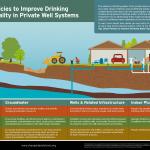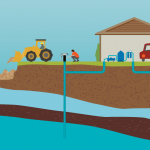Improving Well Water Quality & Well Stewardship
Case studies on promoting policy change in private well systems
We often take safe drinking water for granted. Yet families across the country drink water from private wells that are not subject to federal safe drinking water standards.
Their water usually looks and tastes clean, but in fact, it may be contaminated with harmful bacteria, nitrates, or arsenic. Exposure to these contaminants can lead to serious health consequences, affecting entire communities.
The good news is that with routine well testing, water treatment, and better access to alternative water sources, we can practically eliminate the harms and risks associated with contaminated wells. State and local agencies play a crucial role in promoting policy, system, and environment (PSE) changes that ensure safe, clean drinking water for all.
ChangeLab Solutions developed these four case studies for staff in state and local health departments who want to learn how to enact changes that improve the quality of private well water and well stewardship in their jurisdictions. These case studies explore key steps that state and local public health agencies can take to move toward PSE changes.
Case Studies
- While seeking to improve implementation of Oregon’s Domestic Well Testing Act, the Oregon Health Authority embraced multiple complementary strategies for improving well stewardship and developed skills in tailoring engagement with different stakeholders.
- In the mid-2000s, the Cerro Gordo County Department of Health in Iowa began working with community and governmental partners to adopt county ordinances addressing arsenic contamination issues that could affect county residents who are served by private wells. In the 2010s, the department and its partners conducted a study of the arsenic issues and succeeded in closing regulatory gaps to protect residents from arsenic, nitrates, and bacteria.
- With naturally high levels of arsenic in groundwater statewide and almost half of the state’s residents using private wells, New Hampshire’s Department of Environmental Services used targeted community well-testing events to raise public awareness and built an online tool to help residents interpret water test results, greatly expanding the scale of its impact.
- With 20% of New Mexicans drawing drinking water from private wells but no tracking system for well-testing results, the New Mexico Department of Health set out to build a statewide database that would allow it to evaluate well contamination risks and, in the process, reaped the benefits of inter-agency collaboration.
For policy options and guidance on how to use policy to improve the quality of drinking water in federally unregulated water systems, see the resources listed below.
Downloads




